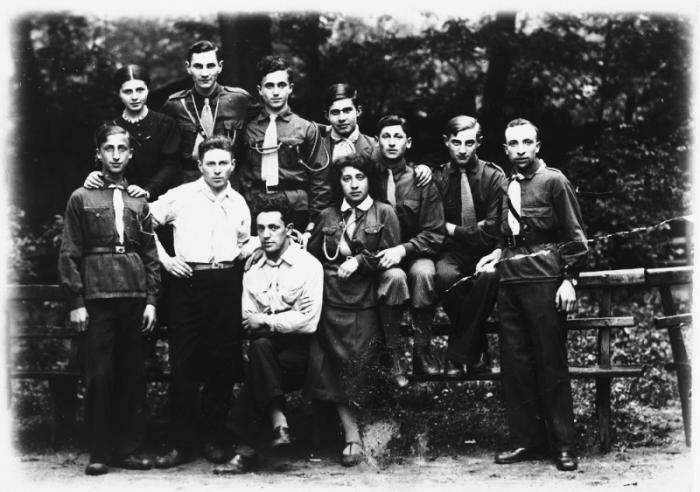
Jewish Community of Kalisz: Youth, Culture, Religion
Youth movements
Youth movements played an important role in the Kalisz Jewish community, and could be found on all points of the political spectrum from the right-wing Zionist Betar organization to the communist Zionist Borokhov organization. Some young Jews joined Zionist training farms in the countryside outside Kalisz to prepare for emigration to Palestine; many eventually emigrated. A number of Jewish communists from Kalisz volunteered to fight in the Spanish Civil War. Ten of them fell in battle.
Schools
The first modern Jewish school in Kalisz, with subjects taught in Russian, opened in 1862. Most children attended one of the seven heders (traditional schools for basic Jewish literacy) in Kalisz. A women's trade school opened early in the twentieth century, and a bilingual Jewish gymnasium (high school) was founded in 1913. In 1917, the religious Zionist Mizrahi party founded a school as part of a national network. Orthodox educational institutions included a kindergarten, a trade school, and a girls' school called Havatselet ("Lily").
During the interwar period, two Yiddish schools were established by the labor Zionist Poale Zion group and the secular socialist "Bund." Many local Jewish children attended Polish public schools. A branch of the national TOZ organization, dedicated to the health of Jewish children, established summer camps for the weak and sick children of the town.
Cultural life
Kalisz had a flourishing Jewish cultural life. In the late 1920s and 1930s, two Yiddish weeklies kept the community abreast of local, national, and international news: the Agudah-leaning Kalisher lebn ("Kalisz Life") and the Zionist-leaning Kalisher vokh ("Kalisz Week").
A group of young people established a branch of YIVO, the Jewish Scientific Society, and conducted research on Jewish folklore and linguistics. The leading figure in Jewish literary life in Kalisz was poet and author Rosa Jakobowicz (Jacobson). The daughter of a rabbi, she studied Hebrew and religious subjects in her youth. After moving to Kalisz as a newlywed, she published her poetry in various journals and periodicals, including a cycle of poems on biblical women, the first of its kind in Yiddish. A collection of her poetry was published in 1924, entitled Mayne gezangen (My Songs). Jakobowicz died in the Warsaw ghetto in 1942. The writer Shimon Horonecki (Horonski) (1889-1939) lived in Kalisz for some years and wrote novels in which can be found descriptions of working class Jewish life in Kalisz.
The performing arts were also cultivated in Kalisz. Jews could enjoy performances of a Jewish orchestra, a brass band, and a theatrical troupe. Local Bund members were especially active in this arena, creating a cultural club, a drama club, a Working Women's Club, and the Comet Amateur Theater.
Sports
Throughout Europe, sports had become an important part of Jewish life, as the political theories of the period stressed the cultivation of the body as well as the spirit and the mind. Each Jewish political party had its own sports club, and the Gymnastics and Sports Association was an important non-political athletic, cultural, and educational organization for youth. The Jewish Rowers' Club of Kalisz participated in competitions at the national level.
Religious life
The foremost personality in the religious life of prewar Kalisz was Rabbi Yehezkel Livshits, who served as rabbi from 1907 to 1932. President of the Rabbinical Association of Poland, a Zionist, and a friend of Chief Rabbi of Palestine Abraham Isaac Kook, Livshits was a force for solidarity and unity in the Kalisz community owing to his character and high standing. After his death, Menahem Mendl Alter, son of the Hasidic Rebbe of Ger, was chosen in part because of the increasing influence of the Gerer Hasidim in Kalisz.
Besides Ger, which counted ten shtieblakh (small prayer houses) in the town, other Hasidic groups represented in Kalisz were Alexander, Sochaczow, Skiernewicz, Kotzk, Sokolow, Parisow, and Radomsk. In addition, the Rebbes of Zychlin and Wola lived in Kalisz. There were so many shtieblakh in Kalisz that some non-Hasidic or non-religious Jews reportedly even closed their windows on Friday nights to escape the loud singing.
During the period between World War I and World War II, the two formal centers of religious life were the traditionalist Great Synagogue and the modern, western-style New Synagogue, called the German Shul. The latter boasted an organ and a choir that performed pieces of liturgical music by both German-Jewish and Russian-Jewish composers.
Critical Thinking Questions
- Learn about the history of the Jewish community in your country.

